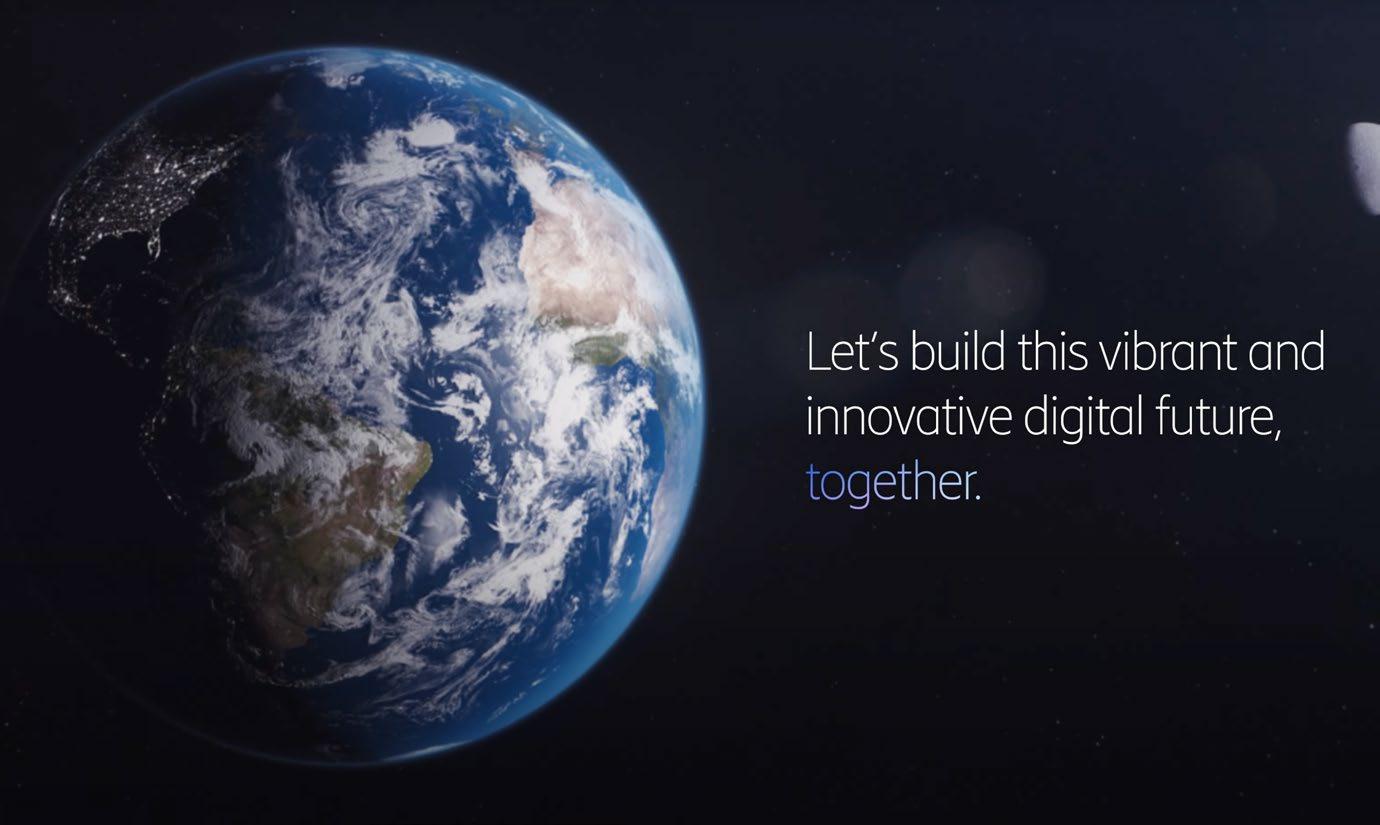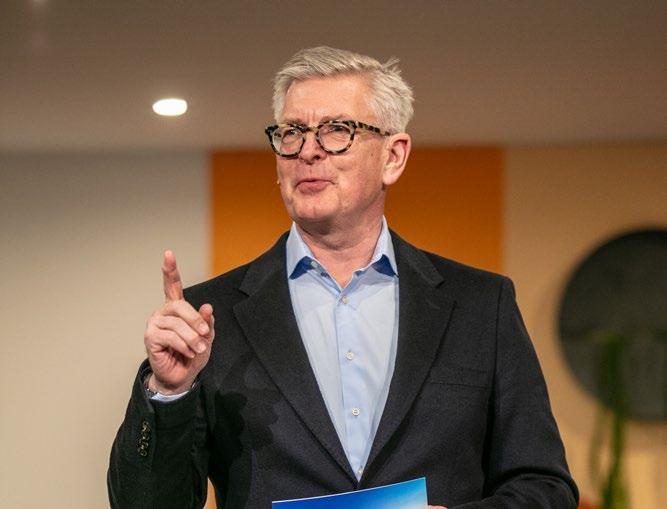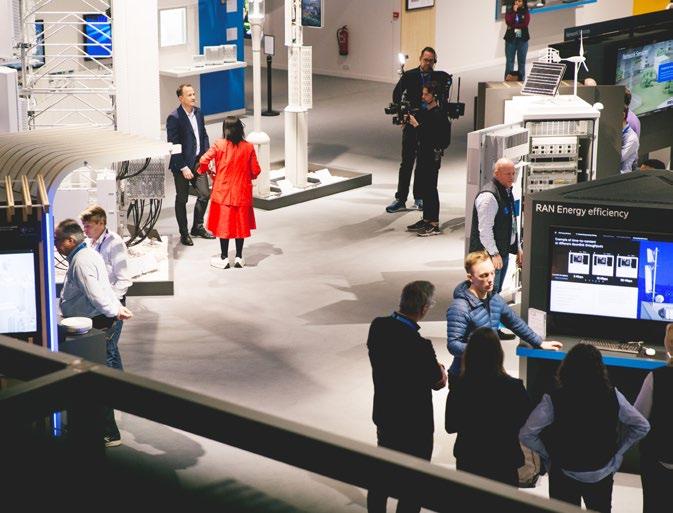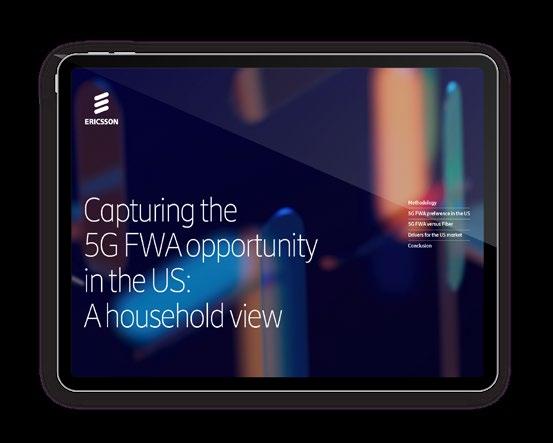
Featured articles
In Alaska, an investment in network modernization sparks transformation
Understanding US consumer sentiment related to Fixed Wireless Access (FWA)



In Alaska, an investment in network modernization sparks transformation
Understanding US consumer sentiment related to Fixed Wireless Access (FWA)

One of the best parts of my job is meeting with our customers, whether at industry events, at our Plano headquarters or in your own locations across the United States. Hearing firsthand about your business strategy, the challenges you face and your opportunities for the future allows our team to focus on how best to serve you. Together, as partners, we can work to create sustainable solutions and drive positive change. We aim to deliver a superior customer experience and while we are far from perfect, you have my commitment to always put our customers first.
As we enter the summer months and approach the half-year mark, I’d like to take this opportunity to thank you for your continued partnership and trust in the Ericsson team.
I hope you enjoy this issue of the magazine, which includes the following highlights and more.
In “Meet the Expert,” we talk to Suresh Ramachandran, Ericsson’s Head of Cloud Software and Services Operations for Regional Carriers, about his many decades in telecom and the exciting changes we’re seeing in the industry. We also look back at Mobile World Congress (MWC) Barcelona 2024, highlighting Ericsson’s immersive demonstrations on the value of 5G, the potential of programmable networks and our vision for future innovation.
Explore the key trends and insights we discovered when we surveyed 2,000 household representatives across the nation to examine how various stages of home broadband internet development in the US market influence consumer choices and perceptions. Plus, hear from three Ericsson experts about Ericsson’s product privacy program, intent-based automation and the benefits of deploying Fixed Wireless Access (FWA) on 5G Standalone.
Join us in celebrating the contributions of more than 200 Ericsson employees and their family members at the 2023 Dallas Heart Walk, benefiting the American Heart Association.
Eric BoudriauHead
ofCustomer Unit Regional Customers and HCPs, Ericsson North America
Imagine possible
Imagination is the curiosity that drives every pioneer and out-ofthe-box thinker to envision and implement ideas that change the world. Check out this video to see how Ericsson and our partners are using the power of our imagination to unlock new levels of intelligence, connectivity and productivity across the globe.


In this issue of “Regional Connect Magazine,” we spoke to Suresh Ramachandran, Ericsson’s Head of Cloud Software and Services Operations for Regional Carriers. Suresh began his career in telecom in the late 1990s doing billing system implementations for North American operators. Over the past 10 years, he has helped customers build and modernize core networks as they transition from 3G to 4G to 5G.

Q: Do you think your experience working with regional carriers helps you better understand customer challenges?
A: Absolutely. The interesting part about regional carriers is the impact they make to improve quality of life is very visible. That’s the feeling I got working for Western Wireless, and it’s still very relevant today. Part of my role and my team’s responsibility is to roll out Ericsson solutions and services to build new capabilities and new products so our regional carriers can take them to market quickly. And that really impacts the local communities.
Q: What excites you most about changes we’re seeing in the industry?
A: The wireless industry started off as a convenience to a few million people, and now it has become an essential service for 6.5 billion people. That’s significant growth. The technology has evolved from 1G, making a simple voice call, to 4G and now 5G, where we’re always connected. When you look ahead, with high throughput and low latency and technologies such as artificial intelligence, there are going to be more use cases that will directly impact communities and individual people. That’s really exciting.
To hear more from Suresh, including how he confronted his fear of heights with bungee jumping, watch the video
Mobile World Congress 2024
February 26 – 29 | Barcelona
MWC Barcelona, held annually in Spain, is the largest and most influential event for the connectivity ecosystem. At this year’s gathering, Ericsson took customers and industry experts on an immersive journey into the future of connectivity.
The spotlight shone brightly on the value of 5G, with an emphasis on building highperforming and cost-efficient networks that are resilient, open, sustainable and intelligent. As we know, 5G is revolutionizing enterprise operations, paving the way for unprecedented advancements in various sectors. Therefore, we challenged visitors to our booth to help us answer the question: How can we shape the future of connectivity together?
100,000+ total event attendees
2,700+ exhibitors and sponsors
9,000+ visitors
(1,200+ from North


 MWC Barcelona 2024: By the numbers
MWC Barcelona 2024: By the numbers
The Ericsson booth showcased immersive demonstrations across four engaging zones:
This zone focused on helping our customers drive and capture the value of 5G through service differentiation, personalization and new consumer applications. We demonstrated how business opportunities in extended reality (XR) will evolve from existing devices and applications to lightweight all-day XR glasses. We also explained why Fixed Wireless Access is an efficient and scalable alternative to wired connections.
This zone focused on helping service providers drive and capture the value of 5G through high-performing, resilient and flexible enterprise solutions and services. Through demos focused on connected vehicles and smart things, Cradlepoint illustrated how Wireless WAN opens opportunities for companies to expand to previously impractical locations, share information to end users through modern digital means and make business offices mobile. Ericsson and Zaphiro Technologies collaborated to demonstrate innovative solutions for the utility industry and highlighted a solution for real-time situational awareness of power system dynamics.
In this zone, we focused on the Ericsson vision—how we intend to create a vibrant and collaborative industry landscape. We highlighted how Ericsson is driving exploration and innovation through various technologies and ecosystems while helping achieve global sustainability goals. We also demonstrated how differentiated connectivity and easily accessible network APIs are critical to building high-performance networks for a broad ecosystem to build upon.
This zone showcased the benefits of Ericsson’s future-proof portfolio of products and services. We displayed radio launches, site solutions (enclosures and light-pole sites), 5G transport, antennas and network services.


Ericsson at MWC
Barcelona 2024: On demand
Explore MWC virtually with our on-demand demonstration broadcasts.
Watch now


In the Ericsson ConsumerLab & IndustryLab study, “Capturing the 5G FWA opportunity: A household view,” we surveyed 2,000 household representatives across the nation to examine how various stages of home broadband internet development in the US market influence consumer choices and perceptions. We discovered the following key trends and insights.
Key trend #1: US households are primed to make 5G FWA a preferred type of connectivity
From an FWA perspective, understanding the overall broadband internet satisfaction levels of households provides opportunities to understand how and where to best position 5G FWA offerings to capture potential growth.
Fast facts:
76% of US households have fixed broadband today
66% report being satisfied with their current home connectivity
47% report that mobile connectivity (via FWA, smartphone, mobile hotspot or similar) is the most used connectivity type at home

Key trend #2: 5G FWA and Fiber compete on a level playing field
US households believe 5G FWA achieves fiber-level performance while delivering an equitable service experience to Fiber. They also rated 5G FWA and Fiber nearly equally when it comes to most other criteria. Notably, 4G FWA was rated below both Fiber and 5G FWA in nearly all categories, highlighting the importance of 5G capabilities and speed, no matter how it’s delivered.
Fast facts:
118 – Customer loyalty index for FWA, compared to 100 for Fiber
105 – Cost level index for 5G FWA, compared to 100 for Fiber
97.5 – Overall network satisfaction index compared to Fiber (100) and Cable (87)
The best way forward
Key trend #3: There is a need for speed, but also availability and convenience
Unsurprisingly, better speed (upload and download) stands out as the biggest driver for US—and global—users. Better coverage or signal strength in certain areas of the house was a close second. Beyond speeds and coverage, selection of FWA depended on availability—putting a spotlight on the digital divide.
Fast facts:
Ease of installation, flexible contracts and customizable packages are top convenience factors of FWA in many households
1 in 2 households are not even aware of FWA as a technology
1 in 5 who know about FWA are not aware of a provider offering it
There is no one guaranteed way to capture the growth potential as indicated by the interest from households. Rather, it should be a localized approach. Download the report to learn actionable steps communications service providers can take to maximize opportunities in 5G FWA.
Get the report
In the late 2010s, after more than three decades serving as Alaska’s largest communications company, while continuing to grow broadband market share, GCI found itself losing wireless customers. Its wireless network was fragmented, assembled through years of acquisitions, and wireless network performance was simply not meeting expectations. By 2019, GCI knew that drastic action was needed and took a fresh approach to its wireless strategy. Partnering with Ericsson, GCI committed to a network modernization project to bring fast, high-capacity 5G to the city of Anchorage, the company’s largest market. GCI and Ericsson rethought and redesigned the wireless network in
Despite having a mere 730,000 residents, the state of Alaska is one of the most diverse states in the nation. Its population comprises Alaskan Native people, immigrant populations and many who came for opportunity or love of Alaska’s abundant nature. In addition to tourism, the state’s lifeblood is largely in the resource development sector—such as oil and gas, mining and fisheries—where connectivity is critical.
GCI Communication Corp. (GCI) is a telecommunications service provider operating in Alaska. Founded in 1979 by Ron Duncan and the late Bob Walp, GCI provides data, mobile, video, voice and managed services to consumer, business, government and carrier customers
Anchorage from the ground up. The combined team upgraded 76 macro cell sites in Anchorage — all within a year and a half, less than the planned two-year timeframe.
The solution deployed Ericsson’s Radio Access Network (RAN) Compute portfolio along with Ericsson Radio System radios. At the centralized core, Ericsson upgraded the network to activate features to support 5G services. GCI now has a powerful and efficient solution for providing higher data rates, a better user experience for subscribers and future-proof 5G capability for the company. The result: Customer churn was reversed, and GCI has experienced an unprecedented 15 consecutive quarters of postpaid growth.
throughout Alaska, serving more than 200 communities. Today, 97 percent of Alaskans live within GCI’s network, and 81 percent have access to the service provider’s 2.5 Gbps internet service.
Connecting a state as vast as Alaska isn’t simple. Alaska’s most advanced network covers more than 10,000 miles— larger than the state of Maryland. The varying and often remote terrain, in some of the most hostile environments in the world, can present daunting challenges to network builders. GCI and Ericsson have a long history of working together on innovative solutions to bring connectivity to the people in Alaska. The trust built over those collaborations led GCI to turn to Ericsson for help in modernizing the network.

Case study: GCI Industry: Telecommunications
Goal:
Modernize GCI’s network to deploy Alaska’s first statewide 5G network with the highest availability and speeds in the Anchorage market.
Approach:
• GCI partnered with Ericsson to rethink and redesign every cell site in Anchorage from the ground up.
• Upgrade included foundations, power, shelters and cabinets, fiber-optic network extensions, all of the backhaul transport equipment, the baseband, the radios, the antennas and the tower structures at 76 macro cell sites.
Results:
• Designed, installed and optimized a best-in-class 5G network in Anchorage in less than the projected two years.
• Delivered Alaska’s first 5G network.
• Greatly improved customer experience.
• Achieved 15 consecutive quarters of postpaid growth.
The solution deployed:
• Uses energy-efficient and high-performing radios coupled with Ericsson’s RAN Compute portfolio, delivering a futureproof 5G network.
• Enables aggregation of spectrum capacity across multiple bands that provide higher data rates and better user experience for GCI’s subscribers.
• Enables 5G functionality in GCI’s core network.

When times are changing, it’s time to change
In the first decades serving the Alaska market, GCI grew quickly. In the late 2010s, however, GCI began experiencing an erosion of wireless subscribers, losing customers to its biggest competitor in the Alaskan market.
Identifying the problems
GCI assessed all factors to determine the extent of their challenges. They found:
• Reliability challenges: The GCI wireless network was a patchwork of technologies, assembled over years of acquisitions with multiple generations of technology and many vendors. This multi-vendor, multi-tenant network bred a fragmented operational model, which made it very difficult for GCI to be proactive, diagnose troubles and then respond in a timely manner. Not surprisingly, service performance and reliability degraded. Performance in the radio access network and wireless core was simply not meeting expectations.
• Limited capacity: By 2019, the capacity GCI provided in its network was not keeping up with customers’ data demands. Each of the multiple technologies in the network required its own spectrum. Yet only a fraction of GCI’s spectrum and acreage was deployed in the market. Its LTE network at the time did not leverage carrier aggregation and only provided a limited amount of capacity to each user. In addition, GCI’s backhaul network capacity was very constrained and didn’t have adequate bandwidth to meet their growing data needs.
• Upshot: Dissatisfied customers. With their needs unmet and a lessthan-optimal experience, GCI’s customers were going elsewhere.
GCI realized it needed to make a change and it couldn’t be minor or incremental. Success would require a transformational shift encompassing the entire wireless network and the entire GCI organization. GCI made a significant investment in transforming its culture and modernizing its network to turn the tide and become the most attractive choice for customers in Alaska.
“As
a company, we didn’t approach this modernization as business-as-usual.
We could see that we needed to make changes in order to create a more sustainable future.”
—Maureen Moore, Chief Customer Experience Officer, GCI
In 2019, GCI decided to take a completely fresh approach to its wireless strategy. It began with what was called “Hometown 5G,” the Anchorage network modernization project. Anchorage is GCI’s biggest market and the state’s largest city, covering approximately 50 percent of Alaska’s population.
“The scope of the Anchorage modernization project is very bold,” said Chris Mace, Vice President of Technology Solutions and Chief Engineer at GCI. “We aimed to design and deploy the first statewide 5G network with the highest availability and the highest speeds in the market.”
That meant rethinking and redesigning every macro cell site in Anchorage from the ground up. GCI also committed to deploying
all of its wireless radio frequency (RF) spectrum assets and all of its wireline fiber and transport backhaul capabilities in the project.
Finding a partner with global expertise and regional focus
GCI set a very aggressive timeline to upgrade and deploy a 5G network and core in Anchorage in less than two years. It needed a partner who could bring both the technology and the proven expertise to ensure a seamless transition to the new 5G network in that timeframe.
Having partnered with Ericsson to connect Alaskans for more than a decade, GCI trusted Ericsson’s unique combination of global experience building 5G networks, end-to-end solution breadth and understanding of the regional market. That gave GCI the confidence that the project would be completed on time and with a high degree of quality.
Ericsson’s modernization proposal aligned well with GCI’s vision and stood out in three key ways, according to Mace:
• First, the proposal was comprehensive, including wireless RAN plus core as well as the operational elements to make sure that GCI could provide a quality service for years to come for its customers.
• Second, the proposal contained both technical and financial elements to make sure that GCI could seamlessly transition from its current RAN and core network to its future network.
• Finally, Ericsson provided 5G industry expertise that wasn’t readily available at the time. In addition, Ericsson had the construction capacity to make sure GCI could deploy its 5G network in Anchorage and meet the project’s very aggressive timelines.

To ensure the 5G transformation in Anchorage in less than two years, GCI and Ericsson had to fundamentally change the way they worked together. They shifted from separate teams with separate project meetings to a fully integrated team co-located in Anchorage. The team held joint daily meetings with all of the engineering, construction and operations resources required to deliver the project.
Eric Boudriau, Head of Customer Unit Regional Carriers at Ericsson emphasized, “we worked very closely with GCI right from the start of the evolution of the network.” Ericsson collaborated with GCI to solidify the network strategy, the definition of the requirements and the execution of the project.
Ensuring future-proof 5G capability
The solution deployed uses Ericsson’s RAN Compute portfolio along with Ericsson’s Radio System and enables the aggregation of spectrum capacity across multiple bands. At the centralized core, Ericsson upgraded the network to activate features to support 5G services. In this way, GCI and Ericsson created a powerful and efficient solution for providing higher data rates and better user experience for GCI’s subscribers and future-proof 5G capability for the company.
“A game changer for the project,” Mace reported, “was Ericsson sourcing a wireless construction subject matter expert to fill a key GCI project leadership position. This expert was able to navigate both GCI and Ericsson to make sure all of the resources between the two companies worked as effectively as possible to ensure we met the objectives of the project.”
Based on the subject matter expert’s recommendation and in collaboration with the project team, GCI and Ericsson were able to adapt to the challenges that arose, adding key resources as needed for the project. This integrated team succeeded in upgrading foundations, power, shelters and cabinets, fiber-optic network extensions, all of the backhaul transport equipment, the baseband, the radios, the antennas and the tower structures at 76 macro cell sites in Anchorage within a year and a half.
Modernizing the enterprise along with the network
“In addition to upgrading the network, we recognized that as an enterprise, we needed to make some structural changes so the whole organization would be ready at the moment the network improvement was complete,” said Maureen Moore, GCI’s Chief Customer Experience Officer. GCI created a crossfunctional working group that brought all of the necessary parties to the table so everything would move forward as the network was being upgraded.
“We prepped ourselves to be ready when the network upgrade was done so that we could welcome customers.”
—Maureen Moore, Chief Customer Experience Officer, GCI
Simultaneously with the network upgrade, GCI invested heavily in its retail store experience training, getting everyone ready. “We wanted it to be fun for our customers and our employees,” Moore emphasized. “We had a whole campaign around ‘Hometown 5G’ that got people amped up and excited about the greatly improved network that they were about to experience.”

The modernized network deployment in Anchorage set the foundation for future opportunities at GCI. Not only did it deploy a significant amount of low- and mid-band spectrum, but it also added the backhaul transport capacity with fiber extensions and enabled 10 gigabits per second of backhaul capability to every site. GCI is now positioned for today’s enhanced mobile broadband use cases, and it’s well prepared for future use cases for consumer and business in both mobility spaces and the fixed broadband area.
With a blazing fast, high-capacity new 5G network, GCI now found itself strategically positioned to offer high-speed data and improved 5G wireless service. Capitalizing on its leadership as Alaska’s largest internet provider, GCI created a highly successful signature premium product called GCI+ that combines wireless lines plus high-speed data.
“The results we achieved as a result of investing in our network exceeded even what our expectations were,” said Moore. “We’ve had 15 consecutive quarters of postpaid growth and seen a significant reduction in churn on customers who choose GCI+. We have our eyes on the future as we expand our 5G network to other parts of Alaska.”
GCI and Ericsson’s partnership continues to expand beyond the Anchorage modernization project. Together, they are continuing to deploy 5G RAN network statewide and to provide geo diversification to GCI’s core wireless network while looking at future ways to further integrate the wireless and wireline networks. “We’re also working on providing innovative solutions such as local packet gateways, innovative
solutions to reach even further remote and isolated communities,” added Boudriau. “That’s GCI’s core mission, and we’re proud to be helping them do that.”
Ultimately, GCI’s customers will benefit most. As the modernization project expands in and beyond Anchorage, Alaskans will see more life-enhancing services delivered to more underserved and remote communities throughout the great state of Alaska.
15 consecutive quarters of postpaid growth

In this edition of “Ask the Experts,” we learn about intent-based automation from Ayodele Damola, Director of AI/ML Strategy, and hear from Customer Solutions Director Rama Datla about the benefits of deploying Fixed Wireless Access (FWA) on 5G Standalone. We also talk to Gagan Shori, Customer Security Director in the Customer Security Unit for Group Function Technology, about the characteristics and benefits of Ericcson’s robust product privacy program.
 Ayodele Damola Director, AI/ML Strategy Ericsson North America
Ayodele Damola Director, AI/ML Strategy Ericsson North America
Q: I hear a lot about intent-based automation. What is it and how might I use it in my network?
A: Intent-based automation offers transformative benefits for communication service providers (CSPs), directly impacting their business outcomes. By focusing on high-level objectives rather than intricate network configurations, CSPs can rapidly innovate and deliver new services, enhancing their competitive edge. This approach enables CSPs to align network behavior with business goals. Through intent-based automation, CSPs can optimize resource allocation, reduce operational complexities and provide tailored service-level agreements (SLAs) to customers, leading to increased customer satisfaction and profitability. Additionally, this level of automation facilitates cost savings by reducing manual interventions and enhancing network resilience and performance.
“How to leverage intent-based automation with AI/ML for 5G RAN” offers a comprehensive exploration of the journey toward zero-touch networks, with a focus on the automation of radio access network (RAN) technology and how it aligns with broader CSP business objectives. Read the article to learn how intent-based automation facilitates the evolution toward autonomous, self-managing networks.

Want to ask our experts to shed light on a certain topic? Submit your questions by contacting your Ericsson account representative.
Q: What are the benefits of deploying Fixed Wireless Access (FWA) on 5G Standalone?
A: As we know, deployment of 4G FWA has become an increasingly common option to grow revenues and leverage unused network capacity. The superior performance and network capacity that is enabled with 5G will further enhance the success of FWA and enable the potential for more fiber-like services. Furthermore, introduction of 5G Standalone (5G SA) further enhances the FWA offering, providing gains in efficiency, performance and differentiation.
Efficiency: Offloading FWA from 4G to 5G brings efficiency in terms of dollars per gigabyte consumed, underscoring the financial soundness of 5G. Migration is simpler as the focus is on non-mobile data-only subscribers. Compared to 5G non-standalone (5G NSA), 5G SA operates without an LTE anchor carrier, resulting in faster connections, immediate 5G carrier access and reduced latency— all of which result in a better end-user experience.
Performance: When combined with Massive MIMO (massive multiple-input multiple-output), the beamforming, single-user and multi-user MIMO solutions further enhance capacity and coverage of the overall network. Introduction for wider carrier channels and uplink MIMO further enhance the user experience.
Differentiation: Service providers can leverage 5G SA capabilities to differentiate their FWA offerings in a competitive landscape. The software solution offers service differentiation and guaranteed performance for many new services, FWA being one of them. It supports dynamic optimization of radio resource allocation and prioritization across different slices for guaranteed SLAs.
To summarize, 5G SA transforms the FWA scenario, emphasizing efficiency, performance and differentiation. Want to know more? Explore the 2024 FWA handbook
Rama Datla Customer Solutions Director Ericsson North America Gagan Shori
Customer Security Director, Customer Security Unit,
Group Function Technology
North America
Gagan Shori
Customer Security Director, Customer Security Unit,
Group Function Technology
North America
Q: How does privacy enhance and optimize the delivery and uptake of Ericsson products and services?
A: Our technology powers entire sectors across the globe. It provides individuals and communities with the ability to instantaneously connect and engage with the world at the touch of a button. However, as communication superhighways broaden and lengthen to democratize the benefits of modern telecommunications technology, the negative externalities associated with this very access are equally exacerbated, and therefore, require the thoughtful implementation of carefully crafted mitigation strategies.
Risk mitigation strategies associated with technology are often grounded in cybersecurity principles and programs, with a focus on everything from proactive access controls to zero trust functionality. However, these technical mitigations—while critical—are made even more powerful and effective when they are deployed in concert with privacy-enhancing features.
Recognizing the gains that can derive from the deployment of a robust product privacy program, we have invested significant resources to enhance our data protection capabilities, with the goal of fostering a privacy-centric culture and optimizing overall business outcomes. Some of the key business metrics that benefit directly from product privacy optimizations include:
1. Enhanced customer trust: By building products and services that incorporate privacy-enhancing features, we signal to our customers and their end users that we acknowledge the trust they place in us by sharing their personal data. Customers who feel that their privacy is respected and protected are more likely to trust the product. This is a fundamental component of some of the most successful technology services and products on the market today.
2. Reduced risk of data breaches: A privacy-focused design and implementation process that incorporates key elements such as privacy assessments at key inflection points in the product development cycle, or implements rules around data retention or minimization, mitigates the risk of data breaches and leaks, which can have severe consequences for both users and the product’s reputation.
3. Regulatory compliance: We are a global company with operations in every region of the world, all of which are characterized by a complex web of regulations governing data privacy. While these regulations might present a diverse set of requirements for compliance, they are often founded on a similar set of principles focused on responsible data use. Incorporating these privacy principles into the fabric of our products is the first essential step in the compliance roadmap and will ensure that we eliminate or at least minimize legal liability and fines and demonstrate our commitment to user privacy.
4. Improved user experience and engagement: By incorporating privacy-enhancing features, we can automatically streamline data collection and minimize intrusive practices. This results in a cleaner and more efficient user experience and makes the product more appealing to users because they are given a greater degree of control over their privacy settings and preferences.
5. Enhanced brand reputation and market differentiation: In an increasingly challenging and competitive market, building a reputation as a company that prioritizes privacy can be a significant differentiator and competitive advantage. Users are increasingly aware of privacy issues and are more likely to choose products from companies that demonstrate an ethical approach to user data that transcends compliance and accounts for broader customer well-being.
A privacy-centric company is an agile company, one that will likely be equipped with the capability to navigate the increasingly restrictive and complex global regulatory landscape and develop products and services that meet user needs while mitigating risks and maximizing opportunities for success.

The Heart Walk is the AHA’s premier event for raising lifesaving research funds and awareness for heart disease and stroke. Each year, more than a million people participate across more than 300 locations.
In 2023, more than 200 Ericsson employees and their family members laced up their sneakers and hit the pavement for the Dallas Heart Walk.
Ericsson was also a proud sponsor of the event alongside AT&T, who has been a multiyear supporter of the AHA.


Between Ericsson’s sponsorship and individual contributions from employees, our team helped raise more than $36,700— the highest amount raised for the AHA by our organization since 2017. And that number continues to climb with post-walk donations.


Our employees’ dedication to participating in this event and selflessly contributing to heart health is an amazing demonstration of Ericsson’s company culture.
“The Dallas Heart Walk was an incredible success this year, thanks to the leadership and unwavering commitment of our 13 walk coaches,” said Rob Johnson, Head of Global Customer Unit AT&T, Ericsson. “I’m incredibly grateful to each Team Ericsson walker who generously gave their time and resources. Each person’s contribution will leave a lasting impact through the lifesaving work of the American Heart Association.”
A leading provider of information and communication technology (ICT) to service providers, Ericsson enables the full value of connectivity by creating game-changing technology and services that are easy to use, adopt and scale—making customers successful in a fully connected world.
148+ years of enabling communication
Global Headquarters: Stockholm, Sweden
28,219 R&D employees*
99,140 employees*
180+ Operates in 180+ countries
60,000+ patents * As of December 2023
162 live 5G networks globally *
North American Headquarters: Plano, Texas
30+ U.S. locations
6 live 5G networks in the U.S.*
7,600 U.S. employees*
70+ regional carrier customers
$100M 5G smart factory investment in Lewisville, TX
Regional carriers are unique enterprises. They are an integral part of the communities they serve as much as they are businesses seeking growth and sustainability. The Ericsson Regional Connect program was born out of Ericsson’s recognition that regional carriers across the US are united by these common values—and by common challenges: Values we share and challenges our global solutions are perfectly suited to meet.
With an array of live and virtual events, online forums and tools, Ericsson Regional Connect comprises a unique community that brings regional carriers together in an unprecedented way:
Connect—Ericsson Regional Connect facilitates a wide range of opportunities for professionals in the industry to meet and partner with their peers.
Share—Regional carriers will have access to Ericsson’s global technological leadership and expertise. And they will have a forum for sharing knowledge, ideas and best practices with one another.
Serve—Apply what you gain from Ericsson Regional Connect to better serve your customers, connect the unconnected and give back to your communities.
Ericsson enables communications service providers and enterprises to capture the full value of connectivity. The company’s portfolio spans the following business areas: Networks, Cloud Software and Services, Enterprise Wireless Solutions, and Global Communications Platform. It is designed to help our customers go digital, increase efficiency and find new revenue streams. Ericsson’s innovation investments have delivered the benefits of mobility and mobile broadband to billions of people globally. Ericsson stock is listed on Nasdaq Stockholm and on Nasdaq New York.
Ericsson
6300 Legacy Drive | Plano, Texas 75024
Telephone (General inquiries): (972) 583-0000 | Telephone (Ericsson U.S. digital sales): (833) 374-7253 www.ericsson.com
The content of this document is subject to revision without notice due to continued progress in methodology, design and manufacturing. Ericsson shall have no liability for any error or damage of any kind resulting from the use of this document.
© Ericsson 2024